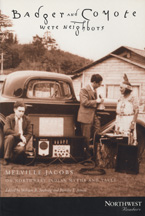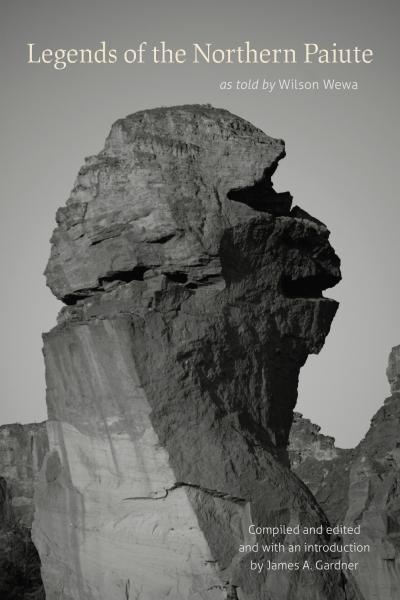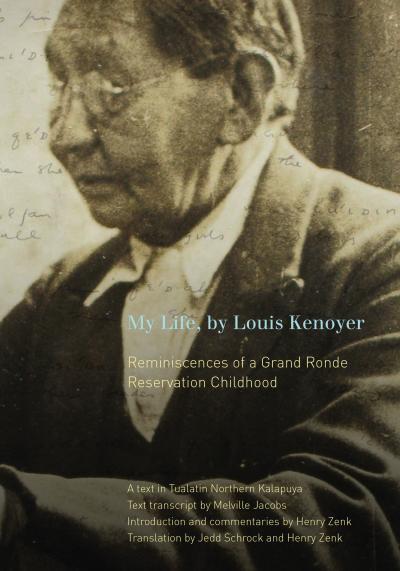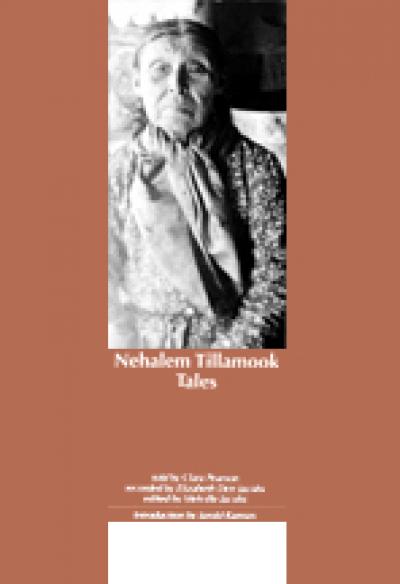
Badger and Coyote Were Neighbors
William R. Seaburg and Pamela T. Amoss
"Story story." For the Clackamas Chinook Indians, these words signaled the end of a myth recital. Melville Jacobs spent a lifetime recording traditional stories and studying the life ways of those who told them. An anthropologist and folklorist, Jacobs (1902-1971) made it his life's work to preserve and interpret the fast-disappearing languages and traditions of the Indian peoples of Oregon and Washington. This volume presents an introduction to Jacobs's seminal research and provides an engaging selection of the myths and tales that he painstakingly collected.
In their introduction, the editors provide an overview of Jacobs's remarkable life and career. A professor at the University of Washington, Jacobs, like his mentor Franz Boas, spent months in the field, seeking out and interviewing Native people. A selection of Jacobs's articles and essays on Northwest Indian oral traditions introduce his theory and method of folklore research.
In addition to his own original writings, this volume gathers eighteen stories collected and translated by Jacobs. Eight of the stories include his extensive interpretations, several of which are published here for the first time. The stories represent the range of genres that Jacobs collected and are drawn from many of the Native groups with which he worked, including Chinook, Kalapuya, Sahaptin, and Coos. All the stories were originally collected in the Native languages and translated into English with help from Jacobs's Indian consultants.
Making possible the scholarly understanding and appreciation of Native folk literature was Melville Jacobs's greatest challenge. This volume in the Northwest Readers series is evidence of his success. It offers a valuable introduction to Jacobs's work for anyone interested in the rich folklore of Northwest Indians, as well as for students and scholars of American Indian oral traditions and their interpretation.
About the author
William R. Seaburg is co-author of Coquelle Thompson, Athabaskan Witness: A Cultural Biography and co-editor of Badger and Coyote were Neighbors: Melville Jacobs on Northwest Indian Myths and Tales (OSU Press). He is associate professor of Interdisciplinary Arts and Sciences at the University of Washington, Bothell. He lives in Seattle.
Read more about this author
Pamela T. Amoss, a former student of Melville Jacobs's, is an independent consultant and researcher. She lives in Leavenworth, Washington.
Read more about this author
Contents
Acknowledgments
Melville Jacobs: An Introduction to the Man and His Work
Bibliography of Melville Jacobs
Toward a Theory and Method of Oral Literature Research
I. Oral Literature
II. A Few Observations on the World View of the Clackamas Chinook Indians
III. Humor in Clackamas Chinook Oral Literature
IV. Genres in Northwest States Oral Literatures
V. Areal Spread of Indian Oral Genre Features in the Northwest States
Oral Traditional Texts with Interpretations
VI. Badger and Coyote Were Neighbors (Clackamas Chinook)
VII. The Old Man and His Daughter-in-law. Her Fingers Stuck Together (Clackamas Chinook)
VIII. She Deceived Herself With Milt (Clackamas Chinook)
IX. Wildcat (Klikitat Sahaptin)
X. Sun and His Daughter (Klikitat Sahaptin)
XI. Coyote's Journey (Upper Cowlitz Sahaptin)
XII. Mink, Panther, and the Grizzly Sisters (Mary's River Kalapuya)
XIII. The Sagandahs People (Miluk Coos)
XIV. An Historical Event Text from a Galice Athabaskan in Southwestern Oregon (Galice Creek Athabaskan)
Oral Traditional and Ethnographic Texts
XV. Coyote, Eagle, and the Wolves (Upper Cowlitz Sahaptin)
XVI. The Basket Ogress Took the Child (Clackamas Chinook)
XVII. Coyote and Skunk. He Tied His Musk Sac (Clackamas Chinook)
XVIII. A Girls' Game (Clackamas Chinook/Chinook Jargon)
XIX. Ethnographic Texts on Spirit Powers and Shamanism (Santiam Kalapuya)
XX. Some Shakers Find the Body of My Brother's Child (Santiam Kalapuya)
XXI. The Origin of Death (Upper Coquille Athabaskan/Chinook Jargon)
XXII. Small Bird Hawk Had His Head Cut Off (Hanis Coos)
XXIII. The Girl Who Had a Dog Husband (Miluk Coos)
XXIV. The Person that Halloos (Miluk Coos)
XXV. The Young Man Stepped on Snail's Back (Miluk Coos)
Notes on Contributors
Permissions
In 1926 Melville Jacobs left New York City and drove west across America to begin his life work, the recording and analysis of the fast-disappearing languages and oral traditions of the Native Americans of Oregon and Washington. He was not the first of an unlikely cadre of city-bred Jewish intellectuals to devote their careers to salvaging and interpreting the life ways of America's first peoples. His mentor, Franz Boas, had set the pattern and his student's, Sapir, Lowie, Kroeber, Goldenweiser and others, followed. There are many ironies in the partnerships that developed between these cultivated urbanites and the old Indian men and women who patiently taught their complex and difficult languages and shared their rich legacy of myths and tales. That it should be children of a denigrated and threatened European caste, newly established in America, who would take responsibility for preserving the heritage of America's equally denigrated and threatened earliest inhabitants, has a certain poetic symmetry. But the symbolic associations were probably lost on the investigators themselves. For them, the enterprise was simply hard work under trying conditions. The languages were totally exotic; the rural settings in which they worked were as alien as the languages and folklore they collected. Fieldwork for most of them began as daunting and continued to be onerous no matter how long they worked or how successful they became. Robert Lowie, from the first generation of these students of Franz Boas, had been forced to grow a beard on his maiden fieldtrip because, as he confessed to his seminar students many years later, he had never shaved himself when he lived in New York, but had always gone to the local barber (Harold Amoss, personal communication, 1999)
Although by the 1920s the second generation of Boas's students, including Jacobs, were American born and raised, they shared much of the discomfort of their predecessors in adjusting to the rustic settings in which American Indians lived. Anyone who knew Melville Jacobs, fastidious in dress and grooming, cultivated and witty, always had difficulty imagining him coping with bad roads, seedy hotels, and truck-stop food. In January 1930 he wrote to Bess Langdon, the woman who would become his wife, describing his trip to Oregon from Seattle:
I had a mad ride down: a blizzard near Tacoma, freezing blasts about Centralia, a suddenly frozen glassed road surface of rain about Kelso, torrents near Vancouver, a billion needles of hail crossing the Columbia, a blind frozen windshield the last score miles, a near wreck in Portland.
Today, I found my indians awaiting me. Not a minute's waiting: I recorded treasures, at once, from Mrs. H. [Victoria Howard, Jacobs's Clackamas Chinook informant]. I had nearly lost her: an automobile sent her to the hospital some weeks ago. She is all patched up and fine for work now. Her nuisance husband has had gout or dropsy or worse since I left him last August, and seems to have recovered for my especial benefit. The road is clear; all I need is Shaeffer's ink, and a sense of humor to put some meaning into the drudgery (letter, Jacobs to Langdon, 19 January 1930).
When Jacobs prepared his students for fieldtrips, he always warned them not only how difficult Native American languages were, but also how dismal the settings would be, how lonely they would feel, and how such discomfort and frustration were the essential rites of passage for the professional. Nevertheless, this remarkable man, totally unsuited by personality and background to do what he did, managed by a combination of strong intellect and stronger will, and with the cooperation of equally remarkable Indian people, to amass and preserve a genuine treasure of Native American languages and traditions. Furthermore he was a leader in the drive to convince the scholarly world that Native oral traditions deserved the same kind of respect, and would reward the same kind of careful analysis, previously accorded only to the written treasures of the western canon.
The selections in this volume from Jacobs's writings were chosen to illustrate his folklore research. We deliberately excluded the more technical linguistic works, the works on race, and his book reviews covering the wide range of his interests--from folklore, to race, to the history and sociology of the Jews. We concentrated on his analysis and interpretation of American Indian folklore, which he himself believed to be his true contribution to anthropology. We have arranged the material in three sections. First are five articles and chapters that illustrate his theoretical orientation. Two of them focus specifically on the Clackamas Chinook oral traditions, because it was in the interpretation of the Chinookan text that Jacobs attempted to demonstrate the merits of applying his structural-psychological model to Native American folk literature.
Section two consists of nine examples of Jacobs's discursive style of text interpretation. The stories are taken from the Clackamas Chinook, Mary's River Kalapuya, Klikitat Sahaptin, Upper Cowlitz Sahaptin, Miluk Coos, and Galice Athabaskan languages. We have included Jacobs's translations of the stories and his interpretations. Five of the text interpretations are published here for the first time.
Section three presents eleven additional stories representing a range of genres which Jacobs collected, and drawn from the Native American groups he worked with.




